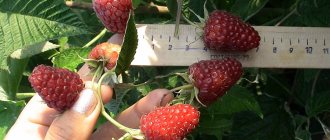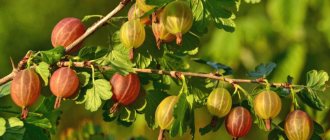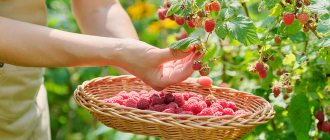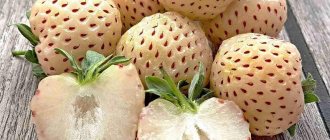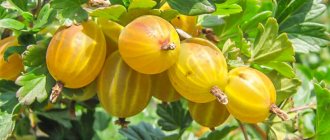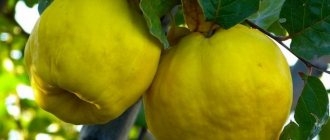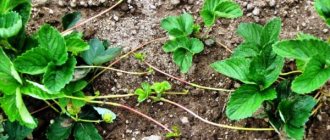Caring for remontant strawberries in the fall
In September and even October, the bed continues to be watered. At this time, strawberries (the correct botanical name is garden strawberry) lay flower buds. With autumn water shortages, next year's harvest will be modest. At the end of October, you need to do the last, moisture-recharging watering, thoroughly wetting it into the soil to a depth of 20 cm.
Advice. How to check if strawberries have enough moisture? Make a hole 10 cm deep in the garden bed, take some soil from the bottom and squeeze it. If the lump in your palm holds its shape, then there is no need to water it. If it crumbles, it’s time to water the garden bed.
The soil needs to be kept clean all autumn - weeding, removing unnecessary tendrils. If there are a lot of spots on the leaves, then in early October it is useful to treat with Bordeaux mixture. To ensure high-quality spraying, you should first clear the bed of weeds - then the fungicide will reach every leaf.
Preparatory work in the fall
For remontant strawberries, several winter months are a real test, especially if the winter has little snow. In the fall, it is necessary to properly carry out all the work to prepare the berry crop for winter so that the strawberry rosettes do not freeze. Strawberries should meet the winter with sufficiently increased green mass. It will protect the plant buds from frost.
Gardeners need to check every bush. The root collar should not stick out of the ground; you need to sprinkle it with earth. At the end of summer, the ground around the bushes is loosened and then mulched.
If the winter is snowy, it will reliably cover all the bushes. But what to do if there is no snow at all? In this case, leaves or hay will become shelter. Such materials will protect the crop from frost, but they are not very convenient, they get wet from moisture, and in the spring it is very difficult to clean strawberry rosettes from them.
With frequent thaws and high humidity, the bushes may dry out. Another drawback is that mice like to spend the winter under straw; they can damage the roots.
Feeding
The easiest way is to use a complex fertilizer designed for use in the fall: Organic mix autumn, Hera autumn with silicon. They contain the elements needed at the end of the season in the correct proportions.
Autumn is a good time to add organic matter. Over the winter, it will completely decompose and be absorbed into the ground with melt water. The optimal thickness of the layer of humus or compost is 5-7 cm. This amount is enough to feed plants and cover the soil. Strawberries mulched in the fall are less overgrown with weeds and winter better. In the spring, it receives a lot of nitrogen, which is necessary for a quick start and an early harvest.
https://youtu.be/poHUGH9JjdE
Agricultural technology in open ground
Abundant fruiting is impossible without providing plants with nutrition and moisture. Therefore, it is important not only to choose the right place for the crop, but also to apply the necessary fertilizers in a timely manner.
Selection and preparation of beds
Well-lit areas without shade are best suited for planting. The soils are sandy loam and loam with a neutral reaction in terms of acidity. Strawberries also grow well in slightly acidic soils, but clean peat bogs are not suitable for them.
The beds are prepared in the fall for planting in the spring or in mid-summer for autumn planting. What they do:
- dig up the soil;
- remove weeds and rhizomes;
- fertilize by adding humus, compost (a bucket per 1 m²), ash (5 kg each).
From mineral fertilizers, potassium sulfate and superphosphate are applied to the crop (20 and 40 g per 1 m²).
Transplanting
The timing of planting seedlings is determined taking into account the climate of the area. In the south and in the middle zone, the best time for planting is autumn, in the North-West, in the Urals - spring (May).
When to replant strawberries: spring, summer or autumn
On a note! In the northern regions, when planted in autumn, seedlings may not have time to take root before the onset of cold weather. Therefore, the spring option is preferable.
They are planted in rows, in a carpet, maintaining a specific distance in each case. It is convenient to plant in three lines, when the holes are 30-40 cm apart from each other, the rows are 90 cm apart. The growth point (“heart”) of the plant should be at the level of the soil surface.
The seedlings are watered, the soil is lightly compacted and mulched. Hay, straw, and humus are used as mulch.
Rules of care
Basic care techniques are standard:
- watering;
- feeding;
- pruning;
- treatment against pests and diseases.
Fertilizing remontant strawberries
The amount of fertilizing for a richly fruiting crop is 5-6 times per season. Timing - in phases, starting from the spring period, when the plants emerge from under the snow, and ending in the fall before wintering.
In the spring, plants need to get stronger after the cold, so they need compounds with a predominance of nitrogen. This will help to quickly adapt to new conditions and form young shoots.
Add mullein diluted in water (1:10) 0.5 liter per bush, nitroammophoska, poultry droppings diluted in water (1:20).
At the flowering stage, garden strawberries need potassium. Therefore they use:
- potassium nitrate;
- wood ash.
On a note! Potassium improves the taste of berries and promotes the accumulation of sugars.
In addition to root feeding, it is useful to treat the crop at the stage of formation of flower stalks by leaves. Ready-made preparations for foliar feeding give good results:
- "Hera";
- "Agros";
- "Ruby".
Solutions of potassium nitrate (1 teaspoon of fertilizer per 5 liters of water), zinc sulfate 0.02% are suitable. It is advisable to spray on the lower leaf blades, as they absorb beneficial components better.
The next feeding is at the stage of ovary formation. Use diluted compost or mullein. It is also useful to spray the plantings with a solution of boric acid and potassium permanganate. Regular strawberries can do without fertilizing, while remontant varieties without fertilizing will give a low repeat harvest.
In the fall, after fruiting, plants need additional “dinners”. Plants should not be fed only if the plantings are rejuvenated and are not preserved for the next season.
Add under strawberries:
- potassium nitrate;
- solutions of the drugs “Florovit”, “Kemira autumn”;
- Fitoverma solution;
- potassium humate.
Compositions with nitrogen are not suitable, since the bushes will begin to intensively grow the ground part, which has a bad effect on the wintering of the crop.
Watering
The roots of the plants are located in the surface layer; with a lack of moisture, the growth and development of strawberries slows down, and the number of flower stalks decreases. It is important to water the bushes regularly so that the soil does not dry out.
For remontant species, it is convenient to use drip irrigation systems, when moisture is directly dosed to the roots of the plants. Mulching is recommended, which slows down the intense evaporation of moisture from the surface of the earth and prevents the soil from drying out.
Adult bushes are watered once every 3-4 days, young seedlings - daily (about 2-3 weeks). In August and September - once a week, taking into account the end of fruiting of the variety and the presence of precipitation.
It is important to carry out irrigation only with warm and settled water, preferably in the morning or late afternoon. After watering, loosening is mandatory if mulch is not used. Many summer residents combine watering with fertilization.
Trimming
In remontant varieties, flower stalks are constantly formed, so leaves are not trimmed during the growing season. Only dry, old, deformed leaf plates are removed.
Plant tendrils that take away nutrients are regularly trimmed. If it is necessary to propagate the variety in the second half of summer, leave 1-2 tendrils on the healthiest and most beautiful bushes, and root the rosettes to obtain young planting material by autumn.
On a note! Experienced gardeners separately grow bushes with tendrils in the beds to obtain rosettes and bushes with flower stalks for harvest.
Remontant strawberries - pruning
In October, cut off all the flower stalks - anyway, the berries on them will not have time to ripen. Remontant varieties bear fruit from early summer until late autumn, so they are never completely pruned - it is enough to remove diseased and damaged leaves. This needs to be done regularly, and not just in the fall. For work, take a pruner with thin blades or regular scissors. You need to use the tool carefully, without damaging the roots and central part of the bush.
After cleaning from diseased and drying leaves, treatment with copper sulfate or another fungicide will be required. You can pick berries after protective spraying after 7 days.
Features of culture
Even experienced gardeners do not fully understand what the term “remontant” means. Let's try to figure it out together. The formation of fruit buds in garden strawberries, which are often called strawberries or Victoria, depends on the length of daylight hours. Most gardeners grow short-day strawberries in their dachas, the berries of which ripen in late May or June. Fruiting occurs once, bud formation occurs in the fall.
A feature of most remontant varieties is a neutral attitude to the length of daylight hours, setting buds every 7-8 weeks. The difference with conventional varieties is significant, since neutrals ripen either in waves or constantly, without interruption until autumn.
On a note! A more accurate definition of the remontant characteristic would be not repeated, but continuous fruiting of the crop. Therefore, the so-called neutrals according to the classification are included in the group of remontant varieties.
The group of hybrid and varietal remontant forms includes garden strawberries of domestic and foreign selection (Dutch, Italian, German, Polish, American). Large-fruited varieties and small-fruited ampelous varieties are popular, characterized by productivity and excellent aroma. But a rich harvest, and even more so a continuous one, is possible only if agricultural techniques are followed. Growing and caring for them are labor-intensive, since plants that are undemanding in terms of daylight hours require adequate nutrition and regular watering.
Reviews about repairers are contradictory, but most often it turns out that unsuccessful results are associated with violation of agrotechnical rules and lack of disease prevention.
Shelter for the winter
Many remontant varieties are heat-loving and do not tolerate long winters. To prevent the bushes from freezing, they can be covered in late autumn. The optimal time for this is when the temperature begins to drop below 0°C and the top layer of soil freezes slightly. If you put up the shelter earlier, the plants may dry out.
What kind of shelter is suitable for remontant strawberries? If a lot of snow accumulates on the site in winter, it is enough to fill the soil between the bushes with compost or humus. If snow is blown out, the beds need to be covered with a layer of spruce branches.
An excellent material for protecting strawberries is straw, but it is difficult to obtain. You can simply fill the bed with dry leaves brought from the forest. This method is available to everyone, but has a drawback - if the winter is mild and damp, the foliage will begin to rot and infections will spread to the plantations.
A good cover is non-woven material. It needs to be pulled over low arcs. In winter, the tunnel will be covered with snow and the strawberries will overwinter well. Under the spunbond she is not afraid of either frost or damping off.
Now you know how to care for remontant strawberries in the fall so that they overwinter well and produce a magnificent harvest next year. Do you have such a berry on your plot? Tell us in the comments what varieties you like, and what you prefer to do with remontant strawberries in the fall: cover them or do they overwinter well without protection? On our channel there is a short master class on autumn pruning of strawberries - take a look, you won’t regret it!
Preparing for winter
Strawberries for the winter should be prepared in the fall.
The entire process of preparing for winter consists of several stages, the implementation of which will allow the plant to survive the winter normally. The last preparatory measures before the winter period are carried out in October, at this time fertilizers are applied, and if necessary, the beds with strawberries can be additionally insulated. The last harvest of remontant strawberries is harvested in October and they are also prepared for the onset of winter.
- Reduce watering. Stopping watering will signal the plant that the growing season has stopped. The last watering should be carried out no later than mid-October after applying fertilizer. You can stop watering garden strawberries in early September.
- Bush pruning.
- Insulation. Typically, strawberry bushes survive the winter normally without the use of a covering, but in severe frosts with low precipitation, the strawberries should be insulated. If there is a small layer of snow, it can be raked onto the bush, thereby creating a natural fur coat. In the complete absence of snow, additional insulation is required. To do this, dry leaves or a manure-straw mixture are poured onto the bed in an even layer. The use of such materials for insulation is convenient because in the spring there is no need to remove them, and the material itself serves as an excellent fertilizer.
- Protecting flowers from frost. Remontant strawberries can bloom for a long time, this can lead to the flowers being damaged during night frosts, which will also affect the condition of the bush. To prevent this process, it is recommended to pick off flowers after frost or use methods to preserve heat around the bush. For this, a film can be used to cover the plants at night and remove them in the morning. You can also place buckets of water in the spaces between the rows, this will also prevent damage to the flowers.
To get the best harvest, you should know how to properly prepare strawberries for winter.
In climatic conditions in which there is little precipitation, even mild frosts can be destructive for the bushes, so they should be additionally insulated. Particular attention should be paid to remontant varieties of strawberries, this is due to the fact that the plant is severely depleted during the growing season due to constant flowering and formation of berries; such bushes are not able to cope with the cold on their own. Preparing a strawberry bed for winter must be done correctly, then the harvest of berries next season will please the gardener with the quality and quantity of the harvest.
Care after first fruiting
Caring for strawberries in summer is carried out very often and carefully. There are several rules that must be followed at this time, and breaking them can lead to loss of crops and even bushes. Let's take a closer look at them.
Immediately after picking the berries, the bushes are fed, since all the energy and nutrients have already been spent on the formation of berries. Before this, it was impossible to carry out leaf treatments, since the berries would become toxic and their consumption could be harmful to the human body. For processing, you can use urea (20 grams per 10 liters) or ammonia fertilizers. It would be a good idea to fertilize with superphosphate
It is important to remember: the procedure is relevant only for ordinary varieties, since remontant varieties will bear fruit again in a week or two and the berries may absorb harmful substances. You cannot top up the bushes, as many gardeners like to do. Excessive cover of the bushes will limit the access of oxygen and if it is too hot outside, the roots will simply smother underground. Plant feeding is not carried out after August 10
If you have late varieties of strawberries, then this procedure should be excluded from the list. Pay special attention to nitrogen fertilizers - they are generally not recommended to be applied after spring, as they contribute to the growth of the plant’s vegetative mass. If the movement of substances does not stop before the first frost, the bushes will freeze completely in winter. Loosening the soil is necessary after the first harvest is harvested. Even if you use agrofibre or film, you still need to remove it and loosen the soil.
Follow these points, and the second fruiting will be as abundant as the first and will bring you many large and juicy berries.
How to arrange the plantings
To achieve the highest productivity (of course, if there is free space), you should create 4 beds with constantly updated plants:
- Garden strawberry bushes are planted in the first plot in the fall. Next year you will receive high-quality seedlings from this ridge, with which you will plant the second plot;
- A year later, from the second plot, strawberry seedlings are planted in plot 3, and in the first plot you get a full harvest;
- In 2 years, you will have two excellent fruit-bearing beds, one bed with young strawberries, and you will plant seedlings in the last plot;
- After 3 years, plot 1 is dug up - after all, it has already produced fruit for 3 years, and young seedlings from plot 4 are planted.
However, replanting alone cannot ensure high yields. It is necessary to provide your pet with optimal conditions for good fruiting.
Expenses
Like any other business, planting and caring for garden strawberries requires certain investments. When choosing a variety, you should first of all inquire about its yield. Depending on the scale of your strawberry business, choose the type of greenhouse - polycarbonate, glass or frame covered with plastic film. The cheapest option is a film greenhouse, but it will not be able to reliably protect the crop from frost. Therefore, it is better to plant and care for remontant strawberries in a glass greenhouse. But it will cost you quite a lot, especially if you build a greenhouse from scratch. The best solution is a polycarbonate structure. If you plan to grow produce in large volumes, choose this type of greenhouse.
To equip 1 sq. meter of greenhouse, you will have to spend 6 dollars. The same amount of money will be spent on purchasing planting material. Accordingly, 1 sq. a meter of crops will cost you $12. To these expenses should be added monthly bills for electricity, heating, employee salaries and transportation costs.
Planting young seedlings
Garden strawberry seedlings are planted in spring (20.04 – 10.05) or autumn (16.08 – 31.08):
- Before planting, seedlings are kept in a cool room for at least 5 days;
- The best time for planting is the second half of the day;
- Excess leaves are removed, especially old and dried ones, leaving only the two inner green leaves. This is a prerequisite for good survival. Otherwise, the root system may not cope and the plant will die;
- The roots are dipped in a mixture of equal parts clay and peat;
- Place the seedlings in the hole, having first straightened them along their entire length. The ideal option is to make a mound and “plant” a bush on it, placing the roots along the edges. At the same time, do not forget about the main rule when planting garden strawberries - do not cover the heart with soil. It should be slightly above the soil level, and at the same time the root collar should be completely in the ground;
- After placing the seedling in the hole, the soil around it is compressed and leveled, while making sure that the roots do not remain hanging in the void, but have full contact with the soil;
- After planting, water (plentiful in dry weather).
Important! If you bought strawberry seedlings in cups, the roots will definitely curl. They should be straightened, rotten ones removed, and, if necessary, shortened
Proper planting will increase the chances of good survival of the bushes.
How to rid strawberries of pests
An important part of autumn work is ridding plants of pests that remain overwintering in the ground and dried foliage.
The main pests of strawberries are powdery mildew and spider mites.
The first thing you can do is remove diseased, blackened leaves , then burn them. Weeds should also not be left in strawberry beds.
When removing tomato bushes in a greenhouse, prepare a healing solution that will protect the berry bushes from pests:
- Pour 1 kg of tomato tops into 10 liters of hot water;
- let it stand for 3 hours;
- then let simmer for 30 minutes.
Place half a piece of grated laundry soap into the cooled infusion. Then, diluting the infusion in a ratio of 1:2, water the beds from above so that the infusion lingers on each leaf.
If the strawberry has mustaches, then the mustaches must be trimmed with pruning shears (but not torn off) so that they do not draw the juices necessary for wintering from the mother bush. In the first year, it is advisable to remove all the whiskers from the garden without leaving them for reproduction.
Removal of the mustache should be carried out in the morning or evening, leaving a 10-centimeter process. To rejuvenate strawberry beds, do the following:
- Find the strongest mother bush in its second year of fruiting. They produce the most productive strawberry bushes.
- Select large, healthy rosettes in the first row from the mother bush. Leave them, trim the rest.
In the spring they will be useful for updating the beds. In June they are pressed to the ground with staples and watered well.
To ensure rooting is successful, you can water it with Kornevin.
In autumn, the mustache is left only for subsequent reproduction. If the rest are not pruned, they will draw all the strength from the mother bush, then do not expect large berries.
Sales of finished products
Experts believe that growing wild strawberries at home all year round can bring good income if you find reliable sales channels for the finished product. This is the most important and, at the same time, the most difficult matter. In rural areas, almost all residents grow vegetables and fruits, but only a few of them receive a decent profit from this.
Problems with product sales arise from large suppliers. In any store you can find imported apples or grapes, although domestic products are much tastier and healthier. It is difficult to compete with large manufacturers, but despite this, it is quite possible to find and occupy your niche. At first, you can sell strawberries to acquaintances or friends. Word of mouth also plays an important role in this matter.
Do not forget that strawberries are a perishable product, so you need to make sure that they are not mixed in boxes. The berries can also be sold frozen for processing. Such goods are purchased in large quantities by supermarkets and shops. During the season, berries can be sold in bulk to market sellers.
Autumn mulching
Rules for planting strawberries in open ground in spring, summer and autumn Planting patterns Photos and videos
After fruiting or at the end of August, the mulch remaining after spring agricultural work should be removed. In autumn, its layer must be placed at the end of October, this is necessary to protect the strawberries from the cold.
In winter, the best material for covering the ground is considered to be pine needles, dry leaves, straw or mown grass:
- First you need to sort out the raw materials and remove weed seeds from them. The hay is shaken, soaked, and then dried in the open sun.
- Before placement, the beds are loosened and weeded. Mulch is not placed on the strawberries, but mainly on the soil around them.
- The layer thickness should be approximately 13-15 centimeters, since the material settles over time, grass and straw should be spread evenly.
- For such a procedure, ordinary grass from the lawn, as well as weeds devoid of seeds and roots, are suitable, but they must also be dried first.
Peat can be used as mulch in small quantities to avoid over-oxidation of the soil.
It is best to use straw, because when it rots in the ground, an aerobic soil bacterium, such as Bacillus hay, begins to develop, which will later help protect the plant from fungal microorganisms.
